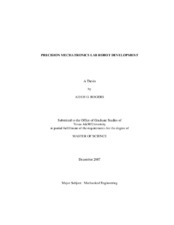| dc.description.abstract | This thesis presents the results from a modification of a previously existing research
project titled the Intelligent Pothole Repair Vehicle (IPRV). The direction of the
research in this thesis was changed toward the development of an industrially based
mobile robot. The principal goal of this work was the demonstration of the Precision
Mechatronics Lab (PML) robot. This robot should be capable of traversing any known
distance while maintaining a minimal position error. An optical correction capability
has been added with the addition of a webcam and the appropriate image processing
software. The primary development goal was the ability to maintain the accuracy and
performance of the robot with inexpensive and low-resolution hardware. Combining the
two abilities of dead-reckoning and optical correction on a single platform will yield a
robot with the ability to accurately travel any distance. As shown in this thesis, the
additional capability of off-loading its visual processing tasks to a remote computer
allows the PML robot to be developed with less expensive hardware. The majority of
the literature research presented in this paper is in the area of visual processing. Various
methods used in industry to accomplish robotic mobility, optical processing, image
enhancement, and target interception have been presented. This background material is
important in understanding the complexity of this field of research and the potential
application of the work conducted in this thesis. The methods shown in this research can
be extended to other small robotic vehicles, with two separate drive wheels. An
empirical method based upon system identification was used to develop the motion
controllers. This research demonstrates a successful combination of a dead-reckoning capability, an optical correction method, and a simplified controller methodology
capable of accurate path following. Implementation of this procedure could be extended
to multiple and inexpensive robots used in a manufacturing setting. | en |


